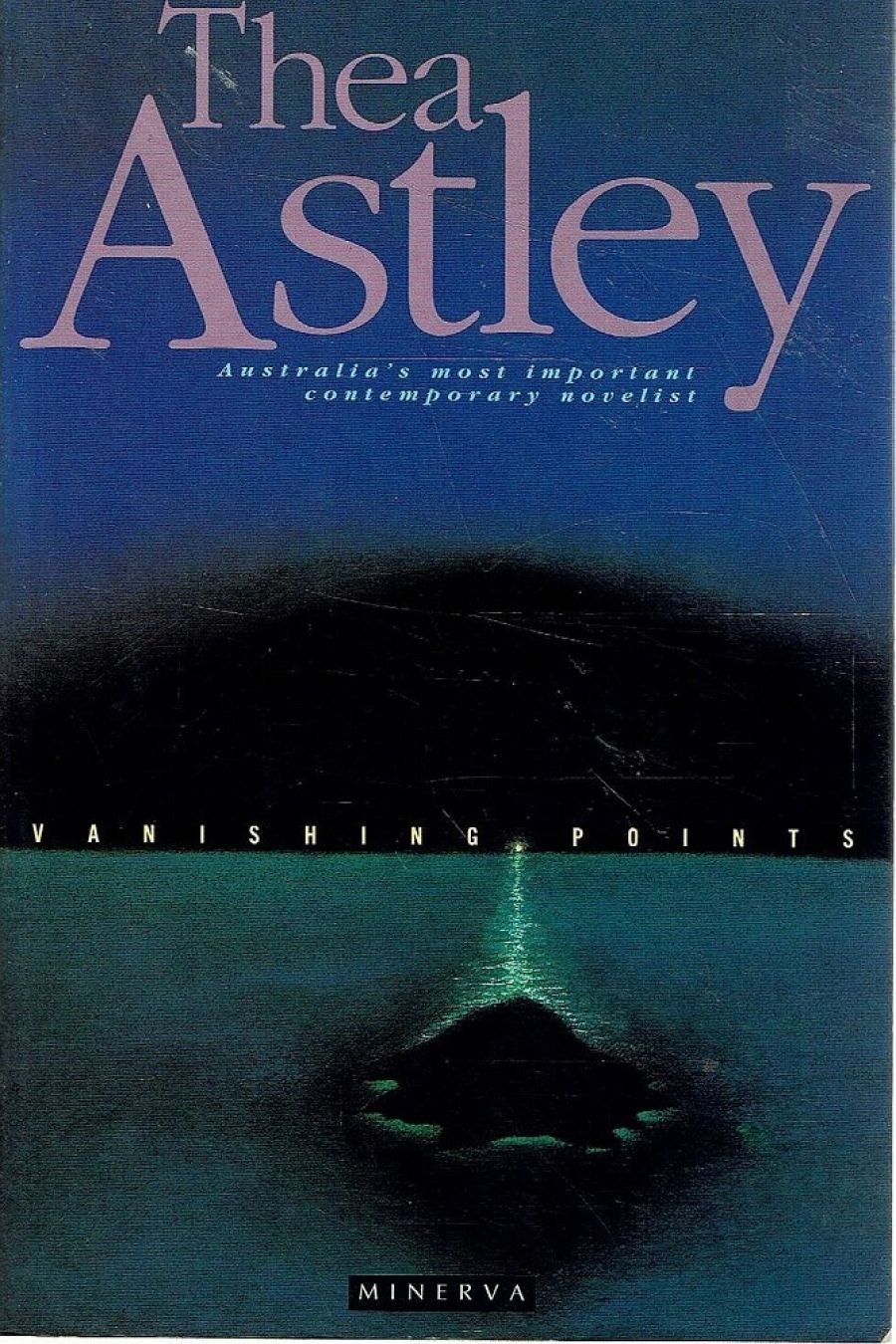
- Free Article: No
- Contents Category: Fiction
- Review Article: Yes
- Article Title: Lines of flight to the north
- Online Only: No
- Custom Highlight Text:
The play of mirror images in this new work of Thea Astley is quite dazzling. She goes from strength to strength in her command of the crafts of narrative. The book is an enquiry into escape, not just any escape, but escape in an almost metaphysical dimension, in which losing oneself is the only way to find oneself. The novel appears to divide into two novellas, linked by the appearance of the villain, and I use the term advisedly, in both. However the two stories are so closely linked in theme, in motifs and in structure, that they are more like twin pictures that form a diptych.
- Book 1 Title: Vanishing Points
- Book 1 Biblio: Heinemann, 234 pp
The first, with the wonderful name of ‘The Genteel Poverty Bus Company’, is told in the third person and shows the increasingly desperate attempts of Mac, a failed academic, to shut out the rest of a society that he sees as determined to persecute him. One of the more successful persecutions of this kind is the ‘conference’ planned by an unkind friend, which opens the book. This reunites Mac, momentarily, with the passengers from a peculiarly excruciating guided tour of the far north, the last fling of the bus company that he has set up. The story, true to the author’s determination to avoid closure, begins in the middle, and the chapters that follow move back and forth in time and space between the tour itself and Mac’s much later attempt to find peace on an off-shore island.
Both the island and the story are built into a maze. The maze Mac cuts from the tropical rainforest to construct the ultimate sanctuary on his island provides a host of seeming entrances, calculated, however, to repel the unwary. So does the book, which determinedly drives the reader back on herself. The island experience is the real tour de force in Vanishing Points. Mac, deprived of his glimpse of paradise by an unscrupulous developer, wages one of the most extraordinary literary battles I have read, a battle not of words but of music, Mozart versus Heavy Metal. He is fuelled by his hate for the resort, and everything it stands for, to the point of total obsession and, in the end, the only way left to him is out to the open sea, to the void, the last vanishing point.
Although the second story, ‘Inventing the Weather’, starts in bitchy suburbia, it too will eventually be dominated by the brooding presence of the rainforest. This one is told in the first person, which is not the only reason one finds it rather easier to sympathise with Julie, the protagonist, than one did with Mac. I spent quite a lot of time cheering Julie on as she ditched her tom-catting husband and egotistical brats and struck out on a line of flight of her own. This story, too, constantly shifts in time and space, but in a more random and less schematic (more female?) way than the first story. Julie has two problems, however. One is guilt and the other, I regret to say, is love. She is, in the mirror image of the text, as obsessed by the need for love as is Mac by the need for hate. My problem was that I had trouble believing the way she found it. We all know it’s the hardest thing on earth to portray goodness, but an outback mission, complete with all-loving and totally wise nuns and a stoically oppressed Aboriginal population, was a bit much for me to swallow.
It’s a pity, but, thank God, Julie’s story is relieved, as is Mac’s for that matter, by Astley’s deft hand with dialogue and the acerbic nature of an interesting range of minor characters. The women, in particular, from the hard-hitting mother figures to the go-getting executives, are made in a new mould, though the old order still lingers in the lamington-making (no, I beg pardon, madeleine-making) clutch of ‘girls’ from whom Julie more or less escapes. Just as Mac is trying to lose himself in a maze of his own making, Julie is trying to create her own weather, but finds, whether she likes it or not, that she’s stuck in other people’s ‘climate’. One of these climates is the ‘what’s in it for me?’ attitude of the children Julie feels herself compelled to mother. This is simple recognition of the fact not only that all children are, and always have been, complete egotists, but that we need a new honesty to admit to, and perhaps to try, a bit of egotism of our own.
The main problem for both Julie and her story is the unrelieved awfulness of her husband, Clifford Truscott. He’s so revolting one simply gets bored with him, as, to be fair, does she. However, when he turns up to evict the nuns and their Aboriginal charges, to whom she has fled in her ultimate line of flight, the whole thing becomes too far-fetched, too, forgive me, black and white. It’s a pity because the structural ingenuity of the ending and its appealing ambiguity, almost, but not quite, win forgiveness for the crass villain versus saint confrontation. I really think Astley fell so much in love with her beautifully sculpted edifice that her usually instinctive believability deserted her. On the other hand, the parallel vanishing points of the Manichean antagonists, Mac and Clifford, mere humans caught in the end between the threatening forest and the unending sea, are wonderfully synchronised.
Astley can write like an angel, and even if the plot occasionally creaks, the beauty of much of the book, the deft use of metaphor in the evocation of the far north, and the intimate landscapes and weathers that it paints, make it compulsive reading.


Comments powered by CComment